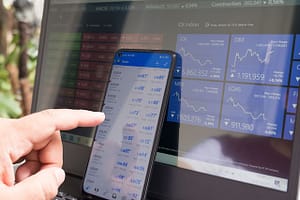Since the entire world is under lockdown, traditional investors are liquidating their equities and portfolios; crypto trading is gaining traction. There will undoubtedly be a rise in new enthusiasts looking to profit from the huge returns connected with crypto markets. Traders and investors all around the world utilise a variety of trading techniques, or rather trading tactics. Because trading style is a product of thinking and perception, there are an endless number of trading styles available.
How to create a trading plan
Here’s a step-by-step guide to developing a cryptocurrency trading strategy that maximises your success chances.
1. Refine your trading goals, method, and time required
Set trading objectives. In this manner, you’re driven by (and learning from) all of your tiny victories as you work your way up to being a seasoned trader. Create attainable goals that are time-bound and practical. Unless you’re utilising trading bots, you may have to choose trading windows that make the most sense for you to track in a 24-hour market.
Examine your schedule and designate yourself daily trading sessions based on how much time you have to concentrate. Some trading strategies will necessitate more trading time than others, so carefully consider your options and availability. Until you’ve settled on your trading objectives, you can choose a trustworthy crypto platform, such as Bitcoin Motion, which provides all the necessary tools needed for a secure and successful trade. Then you can officially begin your crypto journey on this website.
2. Make a trading record
Begin tracking your entry and exit positions in a trading journal from the start. Use an online spreadsheet to access your trading activity from any device — and have a secure backup to ensure that your data is never lost.
Take screenshots of important trades to understand later if necessary. Keep a record of them in your trade journal as well. Logging crypto trading activities is the most reliable technique to evaluate different trading tactics. It also enables you to assess the impact of changes to your technique.
3. Determine which analytics are most effective for you
Choose the type of analytics that will provide you with the most market knowledge and stick to them. Consider comparable analytics from reputable news sources such as on-chain measurements, transaction count, active addresses, and even anticipated socioeconomic aspects. There are a number of convenient tools each trader should refer to.
Source: pexels.com
Make a mental note of the methodology that works best for you, and never stop honing your skills. As part of their trading strategy, many professional cryptocurrency traders keep a spreadsheet containing fundamental and technical indicators. This method simplifies assessing trends and growth at a glance.
4. Define trading styles
Once you’ve experimented with many trading techniques, determining which one best fits your approach and personality might be tough. Unless you’ve tried trading before, you’ll know whether you favour scalping, day trading, range trading, swing trading, trading positions, or inter-exchange arbitrage.
Scalp Traders hold deals from seconds to minutes. Day traders trade only during the day, typically maintaining holdings overnight. Swing traders keep deals for days to weeks, following trends, whereas position traders hold trades for weeks, months, or years.
Observations on trading strategies should also contain basic trading rules learned during trading. Maintain a record of general trading standards. You may even want to determine how much you want to stabilise your portfolio by employing a percentage of coins such as Bitcoin and Ethereum.
5. Establish your holding period
Each trading style and technique will necessitate a unique holding period. Scalpers, as previously said, hold deals for minutes, but swing traders may hold trades for days or weeks. Longer trading times may cause you to become worried. If so, you should stick to shorter ones. Everything is dependent on how you trade.
Your trading style heavily influences your holding duration. As a result, state the length of your trading plan so that you can stay on top of your approach and risk.
6. Create trading strategies
Concentrate on discernible patterns based on your knowledge and experience. Use the trading patterns and indicators that you understand and trust the most as a starting point, but never stop learning and increasing your arsenal when new approaches emerge.
Enumerate each of your trading methods in detail, step by step. Make a detailed list of each step required to open and conclude a successful deal. A step-by-step trading strategy, for example, would take note of the current cryptocurrency price, the trading trigger for your chosen indicators, and your targeted entry and exit positions. This is true even for minute-by-minute analysis.
7. Choose a risk management method
Decide how much of your portfolio you’re willing to risk per trade. Always choose an investment amount that does not exceed your risk tolerance. To determine the worth of deals, many traders use a risk-to-reward ratio. Identify which deals are appropriate for your risk tolerance and record them in your cryptocurrency trading plan.
Develop your own rules to assign to your trading plan. For example, avoid having more than three consecutive losses on the same trade. If you have two or three days of trading losses, reduce your trading budget. Always use a stop-loss to restrict your losses on trades to the value of your portfolio that you are willing to endure.
The takeaway
Trading restrictions are mostly determined by risk tolerance. Nonetheless, you can select percentages such as 5–10% of your transaction amount or 1% of your whole portfolio to limit losses. Maximum loss percentages provide guidelines to follow when you may not otherwise be willing to lock in a loss. Traders’ risk tolerance varies, as do market conditions or circumstances. Once your portfolio has grown ten times, you may feel more confident in increasing trading limitations.
There is no need to watch the market, analyse charts, or use TA when trading positions. Experienced traders choose to leave their newly purchased assets uninhabited and wait for the right market trend to sell them for a high profit. However, depending on the trader’s needs, this process can take months or years. A competent trader suffers through wild trials and tribulations, bears and bulls, FOMO and euphoria, and does not tremble at any news, keeping his purpose in mind.
The above information does not constitute any form of advice or recommendation by London Loves Business and is not intended to be relied upon by users in making (or refraining from making) any investment decisions. Appropriate independent advice should be obtained before making any such decision. London Loves Business bears no responsibility for any gains or losses.



![Berniston review: Five reasons to choose them for trading in crypto [berniston.com] Berniston](https://mloyoq1wv9pf.i.optimole.com/w:300/h:146/q:mauto/f:best/ig:avif/https://londonlovesbusiness.com/wp-content/uploads/2024/07/Berniston.png)


Leave a Comment